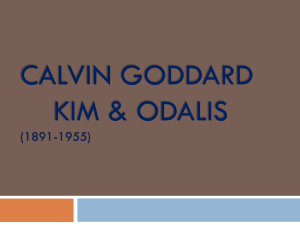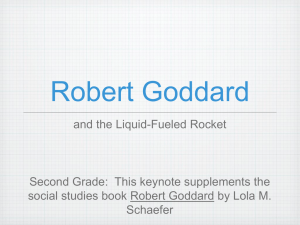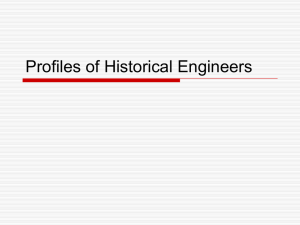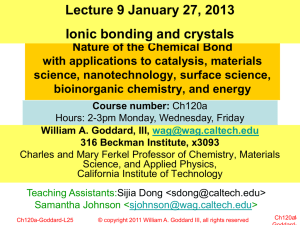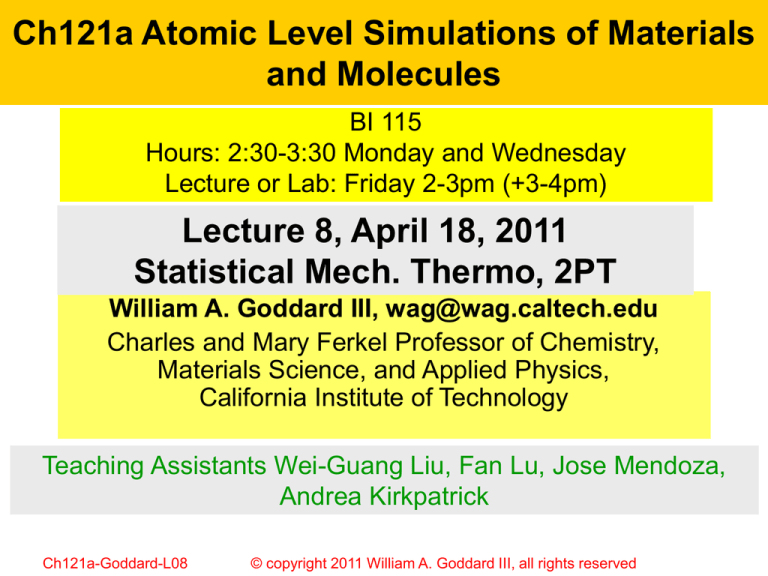
Ch121a Atomic Level Simulations of Materials
and Molecules
BI 115
Hours: 2:30-3:30 Monday and Wednesday
Lecture or Lab: Friday 2-3pm (+3-4pm)
Lecture 8, April 18, 2011
Statistical Mech. Thermo, 2PT
William A. Goddard III, wag@wag.caltech.edu
Charles and Mary Ferkel Professor of Chemistry,
Materials Science, and Applied Physics,
California Institute of Technology
Teaching Assistants Wei-Guang Liu, Fan Lu, Jose Mendoza,
Andrea Kirkpatrick
Ch121a-Goddard-L08
© copyright 2011 William A. Goddard III, all rights reserved
Thermodynamics
Describe a system in terms of Hamiltonian H(p,q) where p is
generalized momentum and q is generalized coordinate
For a system in equilibrium, probability of a state with energy
H(p,q) is
P(p,q) = exp[-H(p,q)/kBT]/Q
which is referred to as a Boltzmann distribution,
Here Q, the Partition function, is a normalization constant
Q = S exp[-H(p,q)/kBT] summed over all states of the system
Ch121a-Goddard-L08
© copyright 2011 William A. Goddard III, all rights reserved
Thermodynamic functions can all be derived from Q
E kT (
2
Energy
T
) N ,V
S k ln Q kT (
Entropy
Helmholtz
Chemical
ln Q
Free Energy
Potential
Pressure
Heat Capacity
Ch121a-Goddard-L08
ln Q
T
) N ,V
A kT ln Q
kT (
p kT (
ln Q
N
ln Q
V
C V 2 kT (
) V ,T
) N ,T
ln Q
T
ln Q
2
) N ,V kT (
2
T
2
) N ,V
© copyright 2011 William A. Goddard III, all rights reserved
The partition function for translation
Assume a cubic periodic box of side L
The QM Hamiltonian is H
2
2
2 m x
2
The QM eigenfunctions are just periodic functions for x, y, and z
directions, sin(nxxp/L) etc
Leading to
n
x
2
2
8 mL
2
h nx
n x 1, 2 ,
Thus the partition function for translation becomes
q trans (V , T )
e
n x 1
Ch121a-Goddard-L08
βε n
x
n y 1
e
βε n
2
y
n y 1
e
βε n
y
( e
βh n
8 mL
2
2
dn ) (
3
2 π mkT
0
© copyright 2011 William A. Goddard III, all rights reserved
h
2
)
3/2
V
Thermodynamic functions for translation
Q= (
2 π MkT
2
)
3/2
V
h
ln
Q
2 ( ln Q
2 ln Q
equipartition
E
kT
)
ln )QN kT
E kT (
Energy
E) N,VNkT
(=
,V
2 (3/2)
,V
Energy
) N ,V
T T E kT ( T
T
2 π MkT 3 / 2 V 5 / 2
lnQ Q
( ln
= klnlnQ
e
S
k
ln
Q
kT
)
ln)Q
2
S k ln Q kTS( k ln )QN ,VN ,kT
Entropy
(
V
N
Entropy
S T
Tk ln Q kT ( T N ,)V N ,h
V
T
3/2
Free
Energy
A
kT
ln
Q
eeHelmholtz
Energy AFree
Energy
kT ln Q A kT ln Q
V
2 π MkT
Helmholtz Free Energy A kT ln Q = -kT
ln
e
2
2
Chemical
Potential
Pressure
Heat Capacity
Ch121a-Goddard-L08
kT (
p kT (
ln Q
N
ln Q
V
C V 2 kT (
h
N
) V ,T
) N ,T
=
NkT
Ideal gas
V
ln Q
T
ln Q
2
) N ,V kT (
2
T
2
) N ,V
= (3/2) k
© copyright 2011 William A. Goddard III, all rights reserved
The partition function for rotation
2
2
1
1
H
sin θ
2
2
2 I sin θ θ
θ sin
This leads to energy levels of
J
J ( J 1)
2I
This is 2 the
Laplacian
I = moment of inertia
2
J ( 2 J 1)
2
J 0 ,1, 2 ,
Thus the partition function becomes
q rot ( T )
rotational
1
σ
( 2 J 1) e
2
βJ ( J 1 )
2I
2
dJ
π
σ
0
temperatu re A
1/2
h
2
(
8 π I A kT
h
2
2
)
1/ 2
(
8 π I B kT
h
2
2
)
1/ 2
2
2
8π I Ak
ω
hv
vibrationa
l temperatu re
v 2011 William
A. Goddard III, all rights reserved
Ch121a-Goddard-L08
© copyright
(
8 π I C kT
h
2
)
1/ 2
Thermodynamic functions for rotation (non linear)
π
1/2
(
Q=
T
3
)
1/ 2
σ A B C
lnQ Q
2 ln
2
2 ln Q
E
kT
(
)
ln )QN kT
equipartition
E kT (
Energy
E) N,VNkT
(=
,V
2 (3/2)
,V
Energy
) N ,V
T T E kT ( T
T
3
lnQ Q
π 1/2 e 3 / 2
T
ln
ln
Q
1/ 2
S
k
ln
Q
kT
(
)
ln )Q
(
)
S k ln Q kTS( k ln )QN ,VN ,kT
Entropy
( = k ln
V
N ,V
Entropy
S T
Tk ln Q kT ( T ) Nσ,V
A B C
T
3
Free
Energy AFree
A Energy
kTln lnQ QA kT ln Q
eeHelmholtz
Energy
kT
π 1/2
T
1/ 2
Helmholtz Free Energy A kT ln Q = -kT ln
(
)
Chemical
Potential
Pressure
Heat Capacity
Ch121a-Goddard-L08
kT (
p kT (
ln Q
N
ln Q
V
C V 2 kT (
σ
) V ,T
) N ,T
ln Q
T
A B C
=0
equipartition
ln Q
2
) N ,V kT (
2
T
2
) N ,V
= (3/2) k
© copyright 2011 William A. Goddard III, all rights reserved
The partition function for vibrations
An isolated harmonic oscillator with vibrational frequency ω
Has a spectrum of energies
n (n
1
)
n 0 ,1, 2 ,
2
rotational
temperatu re A
Substituting into the Boltzmann expression leads to
h
2
2
8π I Ak
ω
hv
e
vibrationa l temperatu re v
n
q=
βω
k
k
1
e
j 1
Summing over all normal modes leads to
β ω/2
q vib
j 1
β n
e
n0
Ch121a-Goddard-L08
e
β ω/2
1 e
βω
j 1
© copyright 2011 William A. Goddard III, all rights reserved
Thermodynamic functions for vibration
(harmonic oscillator)
3n6
Q=
j 1
e
v /2 T
1 e
j
v /T
j
v /T
v
ln
Q
ln
Q
2
Q kT 22 ( = (3/2)
2 ln
/T
E E kT
(
)
Energy
E
) NN kT
kT (
N ,)
V N ,V
,
V
lnT Q
ln Q ,V
j 1 2 T
2
2
e
1
T
E
T E kT
Energy
) N ,)V N ,V
Energy
kT( (
T T ln Q3 n 6 / T
ln Q
ln
Q
/T
v
S S klnk Q
kT
(
)
Entropy
S
k
ln
Q
kT
(
)
ln( 1 e
)
ln Q kT (
N ,)
V N ,V
N,,V
V
N
=
k
ln
Q
ln
Q
/T
kTQ
Entropy
S SkT
( ( T j)1N,)VeN ,V 1
Entropy
ln
ln Q kT
kT
T T 3 n 6
ee
Energy
kT
ln Q
Helmholtz
A kT ln Q
Free
Energy AFree
A Energy
kT
ln Q
v
/T
lnAQ
lnln QQ
Helmholtz Free
Free
Energy
A kT
kT
ln Q = -kT
Helmholtz
Energy
ln( 1 e
)
2T
Potential Potential
kT ( kT
) V ,T(
Chemical
) V ,T
j 1
3n6
j
j
vj
vj
j
vj
vj
j
N
Pressure
N
ln Q
ln Q
p kT ( p kT
) N ,T(
) N ,T
V
V
=0
ln Q
ln Q2 ln Q 2 ln Q v j
) N ,V
acity
) N ,V( kT )(N ,V 2kT ) N(,=
Heat Capacity C V 2 kT (C V 2 kT
V k
2
T
T
T
T j 1 T
2
v
e j
v /T
2
j
(
e
1
)
© copyright 2011 William A. Goddard III, all rights reserved
2
Ch121a-Goddard-L08
2 3n6
/T
q electronic e 1 e
βDe
e1e
q nuclear 1
Q=
e1 e
βDe
Thermodynamic functions for
electronic states
we will assume qelect=1
D e / kT
Assuming the reference
ln Q
2 ln Q
ln
Q
2
2
E E kT
Energy
( = - kT) NND,,VVe
kT( ( E) N,)VkT
state has free atoms
N ,V 2
lnT Q
ln Q
T T
2
Energy
E E kT
) N ,)V N ,V
Energy
kT( (
T T ln Q
ln Q
ln
Q
S S klnk Q
( ( k ln )QN ,
Entropy
(
) NN
ln Q kT
SkT
)V NkT
ln
=
k
,
V
ln
Q
ln
Q ,,VV e 1
T T
T
Entropy
S S klnk Q
( (
) N ,)V N ,V
Entropy
ln Q kT
kT
T T
ee
Energy
kT
ln Q
Helmholtz
A kT ln Q
Free
Energy AFree
A Energy
kT
ln Q
De
lnAQ
lnln QQ
Helmholtz Free
Free
Energy
A kT
kT
ln Q = -De
Helmholtz
Energy
- kT
ln e 1
Potential Potential
kT ( kT
) V ,T(
Chemical
) V ,T
2
N
Pressure
kT
N
ln Q
ln Q
p kT ( p kT
) N ,T(
) N ,T
V
V
=0
ln Q
ln Q2 ln Q 2 ln Q
2 kT (C V 2 kT
) N ,V( kT )(N ,V 2kT ) N(,V = 20 ) N ,V
T
T
T
T
2
acity
Heat Capacity C V
Ch121a-Goddard-L08
2
© copyright 2011 William A. Goddard III, all rights reserved
Thermodynamic Properties for a Crystal
Write partition function of the system
ln Q
As a continuous superposition of oscillators
Harmonic oscillator Partition function
q HO ( )
Q
exp( β n )
n
exp( β h /2 )
1 - exp( β h /2 )
where n
(n
0
1
d S ( ) ln q HO ( )
)h
2
Thermodynamic properties
Weighting functions
1 ln Q
1
E V0 T β
V 0 β d S ( )W E ( )
T N ,V
0
S k ln Q β
1
W E ( )
Q
Reference energy
ln Q
k B d S ( )W S ( )
T
N ,V
0
W S ( )
Q
βh
2
A V0 β
ln Q V 0 β
1
d S ( )W A ( )
βh
exp( β h ) 1
ln[ 1 exp( β h )]
W A ( ) ln
Q
0
E
Cv
k B d S ( )W C v ( )
T N ,V
0
Ch121a-Goddard-L08
exp( β h ) 1
Zero point energy
1
βh
1 exp( β h )
exp( β h /2 )
( β h ) exp( β h )
2
W
Q
Cv
( )
[1 exp( β h )]
© copyright 2011 William A. Goddard III, all rights reserved
2
Where do we get the vibrational density of states
DoS(n)?
Experimentally from Inelastic
neutron scattering
Can use to calculate
thermodynamic properties
Compare to phonon dispersion
curves. Peak is for phonons
with little dispersion
“Phonon Densities of States and
Related Thermodynamic
Properties of High Temperature
Ceramics” C.-K Loong,
J.European Ceramic Society, 1998
Ch121a-Goddard-L08
© copyright 2011 William A. Goddard III, all rights reserved
How can we get the vibrational DoS(n) from MD?
c (r , t )
Consider mass transport
Fick’s Law
combine
j D c
c
t
D=diffusion coefficient
2
D c (r , t ) 0
c (r , t ) (r )
At t=0
2
r
d / 2
c ( r , t ) (2 D t )
ex p
Gaussian
2Dt
Boundary condition:
solution
t
j 0
2nd moment r 2 ( t )
Ch121a-Goddard-L08
r c ( r , t )d r =6Dt
2
Ballistic r = v t
© copyright 2011 William A. Goddard III, all rights reserved
Time correlation
t
t
v ( 1 ) d 1 v ( 2 ) d 2
2
r (t )
0
Write r at time t as
sum of displacement
t
r (t )
dr
dt
0
1
D 3D=
d
0
d
0
v (0) v ( )
t
d 1 d 2
0
v
(
)
d
Take limit as t∞
get
t
t
d
0
v ( 2 ) v ( 1 )
0
1
t
2 d 1 d 2 v ( 2 ) v ( 1 )
0
0
t
1
2 d 1 d 2 v (0 ) v ( 1 2 )
0
0
t
t
2 d 1 d v (0 ) v ( )
0
0
t
From David A. Kofke
kofke@eng.buffalo.edu
2 dD
t 2 t d v (0 ) v ( )
6D=
Ch121a-Goddard-L08
© copyright 2011 William A. Goddard
Green-Kubo
Equation
0 III, all rights reserved
Velocity autocorrelation function, C(t), VAC
C ( t ) v (0) v ( t )
C (0 ) v
2
3kT/m
dkT / m
Lennard-Jones 12-6 particles
Zero slope
Diffusion coefficient =
area under VAC curve
1
backscattering
D 3D=
d v ( 0 ) v ( )
d
Ch121a-Goddard-L08
© copyright 2011 William A. Goddard III, all rights reserved
0
Density of States function
Density of states, DoS(n)
where the atomic DoS is
and
Can also get DoS from Fourier transform of VAC
In terms of atomic vac
Wiener-Khintchine theorem
Ch121a-Goddard-L08
© copyright 2011 William A. Goddard III, all rights reserved
Density of States is Fourier transform of vac
Density of states, DoS(n)
DoS(n) =
is number of states in dn around n
Summing over all DoS gives the total number of normal modes
since
We have
Ch121a-Goddard-L08
© copyright 2011 William A. Goddard III, all rights reserved
Evaluation of Thermodynamic Functions from DoS
Weighting functions
Reference energy
Zero point energy
Note that as n
And
also ln(0)
Ch121a-Goddard-L08
0 get 0 in denominator
© copyright 2011 William A. Goddard III, all rights reserved
Vibrational Spectrum for a solid
35
30
Need DoS(n) 0 as n 0 to avoid
singularities
S ( ) [cm]
25
20
No problem for solids since Debye theory
DoS n3 as n0
15
10
5
0
0
50
k
j
100
150
[cm-1]
S ( ) lim
Ch121a-Goddard-L08
1
2
k
j
k
j
( t) ( t t ' ) dt ' e
i 2 t
dt lim
k
c j (t )e
© copyright 2011 William A. Goddard III, all rights reserved
i 2 t
dt
Density of states for a liquid
Since DoS(0)
is proportional
to the diffusion
constant, have
finite DoS(0)
Ch121a-Goddard-L08
© copyright 2011 William A. Goddard III, all rights reserved
Density of states of a gas
Ch121a-Goddard-L08
© copyright 2011 William A. Goddard III, all rights reserved
Velocity autocorrelation for a hard sphere gas
The velocity autocorrelation function of a hard sphere gas
decays exponentially
c
HS
(t ) c
( 0 ) ex p( t )
HS
3 kT
ex p( t )
N
3
m
4
N
3
H
S
k
4is the
( )
m
c
( t )collisions
cos( 2 t )dt
HS
k frictionSconstant
where
a
Enskog
related
to
the
j
j
0
S ( )
m
c
(
t
)
cos(
2
t
)
dt
kT
j j
0
j 1 k 1
kT
1 k 1
between hardNj spheres.
3
g
g
g
4
g
4
HS
k
3
N
kT ex p( t ) cos( 2 t ) dt
4
S ( )
g m c ( t ) cos( 2 t )dt
kT 0
3 N kT j exj p( t ) cos( 2 t ) dtkT 0
kT 0 j 1 k 1
g
12
N
g
4 12 N g
N g 3
2
4
3 N kT ex p(k t ) cos( 2 t ) dt
2
2
HS
4
S ( ) kT2 0
m
c
(
t
)
cos(
2
t
)
dt
2
2
j j
kT 40 j 1 k 1
g
12 N
42
2 2
g
Ng is the
number
4 3N ofkTeffective
ex p( t )hard
cos( 2sphere
t ) dt particles in the system
kT
0
12 N
g
2
4
Ch121a-Goddard-L08
2
2
© copyright 2011 William A. Goddard III, all rights reserved
The Gas phase component
The Density of vibrational states for the
gas component is completely
determined with two parameters: s0
12 fN
and f.H S
(0) s 0
S
S ( ) S
g
HS
( )
Gas
exponential
decay
S ( )
s0
s 0
1
6
fN
2
Need to define exact value of “fluidicity” factor f that determines
the conceptual partition of the whole system between solid and
gas components. f must satisfy two limiting conditions:
High temperature (low density) limit, the system behaves like hard
spheres, therefore f =1 (no solid component).
High density limit, system is a solid, we expect f=0 (no gas
component)
Ch121a-Goddard-L08
© copyright 2011 William A. Goddard III, all rights reserved
Definition of fluidicity, f
Define f as proportional to the diffusivity, which
automatically satisfies the high density and low
density conditions.
D (T , )
f
D
HS
0
(T , ;
HS
)
D, the self-diffusivity of the system is the hard sphere diffusivity
determined in the zero pressure limit (the Chapman-Enskog
result)
D
HS
0
(T , ;
HS
)
3
8
1
HS 2
(
kT
m
)
1/ 2
To determine f, need now only determine
sHS from the MD
Ch121a-Goddard-L08
© copyright 2011 William A. Goddard III, all rights reserved
Determining the hard sphere diameter sHS . Require diffusivity of
the gas component (at temperature T and density fr) to agree with
prediction from Enskog theory (gives the best transport properties
for dense hard sphere fluids)
The diffusivity of the gas component is determined from the VAC
D
HS
(T , f )
1
3
c
HS
( t )dt
0
kT
m
kT s 0
1 2 m fN
The Enskog theory predicts the deviation of
diffusivity for a dense hard sphere fluid from its zero
pressure limit as
D
HS
(T , f ) D 0 ( T , f ;
HS
HS
)
4 fy
z ( fy ) 1
where z is the compressibility, which can be obtained from the accurate
Carnahan-Starling equation of state for hard spheres
1 y y y
2
z( y)
(1 y )
3
3
y is the hard sphere packing fraction. For a given value of f, these equations
can be solved for y, and thus sHS . However, f is also a function of sHS , must
HS .
solve
simultaneously
for
both
f
and
s
Ch121a-Goddard-L08
© copyright 2011 William A. Goddard III, all rights reserved
For crystals get Free Energies from phonon density
of states. Cannot do this for Liquids since S(0)≠0
Finite density of states at n =0
Proportional to diffusion coefficient
Harmonic Approximation Entropy= ∞
•Also strong anharmonicity at low
frequencies
Solid
Gas
Liquid
S ( )
New Model
2 phase theory (2PT )
Liquid Solid + Gas
S ( )
exponential
decay
Debye crystal
S(v) ~v2
S ( )
solid-like •Two-Phase Thermodynamics Model (2PT)
gas-like • Decompose liquid S(v) to a gas and a solid contribution
S ( )
• S(0) attributed to gas phase diffusion
• Gas component contains anharmonic effects
• Solid component contains quantum effects
The two-phase model for calculating thermodynamic properties of liquids from molecular dynamics: Validation for
the phase
diagram of Lennard-Jones©fluids;
Lin, Blanco,
Goddard;
JCP, 119:11792(2003)
Ch121a-Goddard-L08
copyright
2011 William
A. Goddard
III, all rights reserved
The 2PT Model: Describe the vibrational density of states of a
liquid as a superposition of a diffusional gas-like phase and a
vibrational non-diffusional phase
Property P d S ( )W ( ) d S ( )W ( )
=
Describe the Ndiffusional
gas-like component as a hard sphere
3
4
HS
k
The velocity
autocorrelation
S fluid.
( )
m
c
( t ) cos( 2 t )dtfunction of a hard sphere gas
j j
0
j 1 k 1
decays kT
exponentially
3 kT
4 H S
HS
g
kTp(
exp(
t ) dt
c ( t ) c 0 ( 30N) ex
t )t )cos( 2ex
p( t )
kT
m
s
HO
P
0
g
g
P
0
g
S
HS
( )
412 N
gN
g
3
kT 40 j 1 k 1
2
2
2
m j c j ( t ) cos( 2 t )dt
k
Ng = f N is
number
of effective
4 the
g
3 N kT ex p( t ) cos( 2 t ) dt
0
hard sphere
particles
in the system
kT
12 Nhard
sphere component
f = fractional
2
2
2
4 Measures “fluidicity”
in overallsystem.
g
of the system (depends on both
Ch121a-Goddard-L08
© copyright 2011 William A. Goddard III, all rights reserved
temperature
and density).
• Examples
liquid
LJ gas
1200
30
1000
25
FCC solid
35
30
25
600
gas-like
solid-like
400
0
0
5
Ch121a-Goddard-L08
solid-like
gas-like
15
10
5
[cm-1]
20
10
200
0
solid-like
gas-like
15
S ( ) [cm]
20
S ( ) [cm]
S ( ) [cm]
800
10
5
0
0
50
100
[cm-1]
150
0
50
100
[cm-1]
© copyright 2011 William A. Goddard III, all rights reserved
150
Solid phase system, gas part negligible
Ch121a-Goddard-L08
© copyright 2011 William A. Goddard III, all rights reserved
Validate Accuracy of Predicted Free Energy from MD
For Lennard-Jones Fluid have essentially exact free energies
for full phase diagram from extensive Monte Carlo
Calculations (by others)
T - diagram for Lennard Jones Fluid
1.8
Include: solid,
liquid, gas,
supercritical,
metastable and
unstable
Supercritical Fluid
1.4
Gas
T*
Liquid
1.0
●metastable
●unstable
Solid
0.6
0.0
Ch121a-Goddard-L08
0.4
*
0.8
1.2
© copyright 2011 William A. Goddard III, all rights reserved
S*
Entropy
Free
Energy
and Free Energy from MD nearly exact
Entropy 2PT model
Free energy 2PT model
20
18
16
5
T*=1.8
T*=1.4
T*=1.1
T*=0.9
2PT(Q)
2PT(C)
Lines exact
Circles: MD-2PT
14
-15
8
-20
6
-25
0
0.2
0.4
0.6
*
0.8
1
1.2
• Accurate for gas, liquid, and crystal
• Accurate in metastable regime
• Quantum Effects most important for
crystals (~1.5%)
Ch121a-Goddard-L08
S
M
-10
10
4
M
-5
G*
12
Lines exact
Circles: MD-2PT
0
L
U
U
T*=1.8
T*=1.4
T*=1.1
T*=0.9
2PT(Q)
2PT(C)
-30
0
0.2
0.4
0.6
*
0.8
1
1.2
• Accurate for gas, liquid, and crystal
• Accurate in metastable and
unstable regimes
© copyright 2011 William A. Goddard III, all rights reserved
Pressure and Energy from MD nearly exact
Pressures and Energies from MD agree with exact EOS
For all phases
Total Energy
18
Pressure
16
T*=1.4
2
14
T*=1.1
1
12
T*=0.9
T*=1.8
T*=1.4
T*=1.1
T*=0.9
MD
2PT(Q)
0
MD
10
P*
3
T*=1.8
-1
E*
8
6
-2
-3
4
-4
2
Lines exact
Circles: MD-2PT
-5
0
Density
-6
-2
0
0.2
0.4
Ch121a-Goddard-L08
0.6
*
0.8
1
Density
1.2
-7
0
0.2
0.4
0.6
*
0.8
© copyright 2011 William A. Goddard III, all rights reserved
1
1.2
Validate Accuracy of Predicted Free Energy from MD
For Lennard-Jones Fluid have essentially exact free energies
for full phase diagram from extensive Monte Carlo
Calculations (by others)
T - diagram for Lennard Jones Fluid
1.8
Include: solid,
liquid, gas,
supercritical,
metastable and
unstable
Supercritical Fluid
1.4
Gas
T*
Liquid
1.0
●metastable
●unstable
Solid
0.6
0.0
Ch121a-Goddard-L08
0.4
*
0.8
1.2
© copyright 2011 William A. Goddard III, all rights reserved
• For gas, the entropy
converges to within
15.5
0.2% with 2500 MD
14.5
13.5
steps (20 ps)
2PT(Q)
2PT(C)
12.5
MBWR EOS
11.5
S*
gas (r*=0.05 T*=1.8)
10.5
9.5
• For liquid, the entropy
converges to within
liquid (r*=0.85 T*=0.9)
1.5% with 2500 MD
8.5
7.5
steps (20 ps).
6.5
100
1000
10000
100000
1000000
MD steps
Ch121a-Goddard-L08
© copyright 2011 William A. Goddard III, all rights reserved
Simulation conditions
2.0
supercritical
fluid
1.8
1.6
1.4
T*
1.2
1.0
0.8
•Initial amorphous structure is used
in the cooling process
•The fluid remains amorphous in
simulation even down to T*=0.8
(supercooled)
•The predicted entropy for the fluid
and supercooled fluid agree well
with EOS for LJ fluids
solid
solid
0.6
0.00
0.40
0.80
metatstable supercritical
unstable
fluid
8
1.20
Entropy
•Initial fcc crystal
is used in the
7
heating process
6
•The crystal appears stable in
S*
liquid (EOS)
5
simulation even up to T*=1.8
solid (EOS)
heating
(superheated)
4
starting with
cooling
•The predicted entropies for the
classical
fcc crystal
3
crystal and superheated crystal
0.80
1.20
1.60
2.00
T*
Ch121a-Goddard-L08
copyright
2011 William A. Goddard III, all rights reserved
agree
well with EOS ©for
LJ solids
Diffusion Coefficient From MD (2PT)
Diffusion Coefficient from
S(0)
kT
D
S (0)
12 mN
0.30
T*=1.8
T*=1.4
0.25
T*=1.1
T*=0.9
0.20
D*
DoS
Lines exact
Circles: MD-2PT
0.15
0.10
0.05
0.00
0
0.2
Ch121a-Goddard-L08
0.4
0.6
*
0.8
1
1.2
© copyright 2011 William A. Goddard III, all rights reserved
Application to Water
Ch121a-Goddard-L08
© copyright 2011 William A. Goddard III, all rights reserved
Velocity Auto-Correlation Function
F3C/HQopt water
VAC[tot]
2000000
1500000
1000000
500000
0
0
0.25
0.5
0.75
-500000
Ch121a-Goddard-L08
time(ps)
© copyright 2011 William A. Goddard III, all rights reserved
1
2PT decomposition
for H2O (300K)
25 ps, 1fs steps
)
16
total
S_hs(v)[cm]
14
S_s(v)[cm]
Stot(v)[cm]
12
10
diffusional
8
6
4
vibration
2
)
0
1
16
10
100
log
Total power spectrum (Fourier
transform of velocity
autocorrelation function
S_hs(v)[cm]
14
1000
10000
(cm-1)
S_s(v)[cm]
Stot(v)[cm]
12
10
8
6
4
2
0
0
500
1000
Ch121a-Goddard-L08
1500
2000
2500
3000
The power spectrum
is decomposed into a
gas (diffusive) and a
solid (fixed) spectra
and their
contributions added
to yield the free
energy of the liquid
© copyright 2011 William A. Goddard III, all rights reserved
• Theory: 69.6 +/- 0.2 J/K*mol
• Experimental Entropy: 69.9 J/K*mol (NIST)
Statistics collected© over
20ps of MD , no additional cost
copyright 2011 William A. Goddard III, all rights reserved
Ch121a-Goddard-L08
Dependence of Accuracy on time step used in
velocity autocorrelation analysis of the dynamics
MD was at 1 fs time step
Plot of Sq (J mol
-1
molecule
-1
) vs timestep
350
Need to
keep
velocities at
every 9fs or
more
frequently
q u a n tu m e n tro p y (J /m o l)
300
250
200
150
100
50
0
1
10
100
1000
trajectory read timestep (²t
Ch121a-Goddard-L08
© copyright 2011 William A. Goddard III, all rights reserved
10000
Statistics: Precision across frequency of
sampling
Ch121a-Goddard-L08
© copyright 2011 William A. Goddard III, all rights reserved
Results
Ch121a-Goddard-L08
Water properties
© copyright 2011 William A. Goddard III, all rights reserved
Precision: Across total length of MD
simulation
E nt ro py ( Jo ule s/ K *m o l )
Liquid Entropy of Water (300 K)
Experimental Entropy: 69.9 J/K*mol (NIST)
68.95
68.90
68.85
68.80
68.75
68.70
68.65
68.60
68.55
68.50
0
5
10
15
20
25
MD Time (ps)
Ch121a-Goddard-L08
© copyright 2011 William A. Goddard III, all rights reserved
Applications to several liquids
Thermodynamics of liquids: Absolute molar entropies and heat
capacities of common solvents from 2PT Molecular Dynamics;
Tod A Pascal ,Shiang-Tai Lin and William A Goddard III,
Phys Chem Chem Phys 13 (1): 169-181 (2011)
Ch121a-Goddard-L08
© copyright 2011 William A. Goddard III, all rights reserved
2PT liquid Chloroform, CHCl3
Ch121a-Goddard-L08
© copyright 2011 William A. Goddard III, all rights reserved
Benzene S and Cv convergence
Converged
at 20 ps
Ch121a-Goddard-L08
© copyright 2011 William A. Goddard III, all rights reserved
Standard Absolute Molar Entropy
Ch121a-Goddard-L08
© copyright 2011 William A. Goddard III, all rights reserved
Specific Heat Capacity
Ch121a-Goddard-L08
© copyright 2011 William A. Goddard III, all rights reserved
Accuracy in predicted S from various FF
Ch121a-Goddard-L08
© copyright 2011 William A. Goddard III, all rights reserved
Accuracy in predicted Cp from various FF
Ch121a-Goddard-L08
© copyright 2011 William A. Goddard III, all rights reserved
Components of S from 2PT
Standard Molar Entropy S0(cal/mol/K)
Svib
Srot
Strans
frot MSDa GKb Expc
±
6.28 0.06 13.38
0.08 15.48
0.10
0.16
0.12
1.03 1.18
11.08 0.04 16.84
0.04 19.35
0.05
0.34
0.29
4.39 5.09
acetonitrile
0.93 0.02 13.86
0.08 19.20
0.14
0.40
0.30
7.25 7.93
benzene
4.74 0.06 16.63
0.06 19.83
0.09
0.30
0.29
3.45 3.77
chloroform
5.65 0.02 19.20
0.15 21.12
0.16
0.33
0.30
3.22 3.76
1,4 dioxane
8.43 0.05 16.43
0.09 17.97
0.15
0.20
0.20
1.69 1.82
DMSO
8.87 0.06 13.93
0.08 16.31
0.10
0.16
0.13
0.63 1.09
ethanol
4.51 0.01 13.16
0.06 15.95
0.09
0.20
0.15
1.54 1.82
ethylene
glycol
6.94 0.02 12.03
0.08 14.66
0.08
0.16
0.10
0.33 0.39
furan
3.40 0.04 16.76
0.12 19.87
0.12
0.35
0.30
3.55 4.85
methanol
1.71 0.01 11.38
0.04 16.03
0.06
0.32
0.20
3.39 3.68
2.2
© copyright
201116.32
William A.
Goddard0.21
III, all rights
NMACh121a-Goddard-L08
13.29 0.01 13.59
0.04
0.03
0.10reserved
1.52 1.73
1.2
acetic acid
acetone
avg
±
ftrans
D x10-5(cm2/s)
avg
avg
±
fluidicity
factor
1,4 dioxane
8.43 0.05 16.43
0.09 17.97
0.15
0.20
0.20
DMSO
8.87 0.06 13.93
ethanol
4.51 0.01 13.16
0.06 15.95
0.09
0.20
0.15
1.54 1.82
ethylene
glycol
6.94 0.02 12.03
0.08 14.66
0.08
0.16
0.10
0.33 0.39
0.08 16.31
0.10from
0.16 2PT
0.13
Components
of S
1.69 1.82
0.63 1.09
furan
Standard Molar Entropy S0(cal/mol/K)
3.40 0.04 16.76 0.12 19.87 0.12
fluidicity
factor0.30
0.35
D x10-5(cm2/s)
3.55 4.85
methanol
Strans0.06
1.71Svib 0.01 11.38Srot 0.04 16.03
ftrans
0.32
frot MSD
GKb Exp
0.20
3.39a 3.68
2.2c
avg 0.01
± 13.59
avg
13.29
± 16.32
avg
0.04
±
0.03
0.21
0.10
1.52 1.73
6.28 0.06 17.90
13.38
9.01
0.08 20.05
15.48
0.07
0.10
0.15
0.16
0.33
0.12
0.31
1.03 4.63
1.18
3.92
acetone
toluene
11.08 0.09
0.04 17.45
16.84
11.45
0.04 19.77
19.35
0.07
0.05
0.11
0.34
0.26
0.29
0.23
4.39 3.00
5.09
2.75
acetonitrile
TFE
0.93 0.04
0.02 16.54
13.86
11.21
0.08 18.75
19.20
0.11
0.14
0.12
0.40
0.20
0.30
0.16
7.25 1.56
7.93
1.32
benzene
Waterd
4.74 0.06 16.63
0.06 19.83
0.09
0.30
0.29
3.45 3.77
89
chloroform
F3C
5.65 0.00
0.02 11.54
19.20
0.04
0.15 50.50
21.12
0.06
0.16
0.25
0.33
0.25
0.30
0.06
3.22 3.76
90
1,4 dioxane
SPC/E
8.43- 0.05- 12.03
16.43
0.09 53.05
17.97
0.03
0.15
0.14
0.20
0.29
0.20
0.07
1.69 1.82
91
DMSO
TIP4P-Ew
8.87- 0.06- 13.93
9.53
0.08 49.79
16.31
0.07
0.10
0.07
0.16
0.24
0.13
0.05
0.63 1.09
ethanol
4.51 0.01 13.16
0.06 15.95
0.09
0.20
0.15
1.54 1.82
ethylene
glycol
6.94 0.02 12.03
0.08 14.66
0.08
0.16
0.10
0.33 0.39
furan
3.40 0.04 16.76
0.12 19.87
0.12
0.35
0.30
3.55 4.85
NMA
acetic acid
THF
Ch121a-Goddard-L08
© copyright 2011 William A. Goddard III, all rights reserved
1.2
0.6
Conclusions
• New first principles thermodynamics
model: 2PT
• Provides good results within 0.4%
experimental entropy water
• Errors of 7% for other solvents
• Results in 1-2 CPU hours
• Full Statistical analysis in progress
Ch121a-Goddard-L08
© copyright 2011 William A. Goddard III, all rights reserved
Alternative approaches to Estimation of F
Common indirect method very similar to the way in which
free energies are obtained in real experiments leads to Free
energy differences, not absolute values
MD is used to obtain derivatives of the free energy such as
pressure or energy:
Integrating these derivatives between two well defined
thermodynamic states leads to a change in free energy
Ch121a-Goddard-L08
© copyright 2011 William A. Goddard III, all rights reserved
F
Thermodynamic Integration
The reaction is divided into windows with a
specific value i assigned to each window.
with an additional term correcting for incomplete
momentum sampling, the so-called metric-tensor
correction
Review: Kastner & Thiel, J. Chem. Phys. 123, 144104 (2005)
Ch121a-Goddard-L08
© copyright 2011 William A. Goddard III, all rights reserved
Thermodynamic Integration
Ch121a-Goddard-L08
Review: Kastner & Thiel, ©
J. copyright
Chem. Phys.
2011123,
William
144104
A. Goddard
(2005) III, all rights reserved
Umbrella Sampling - 1
In umbrella sampling, a restraint (a ξ dependent bias) is
applied in each window along the path from state a to state b.
For example
Calculate the distribution P(ξ ) along the reaction coordinate
from a to b
Calculate the dependence of the free energy on ξ (the potential
of mean force
where b = 1/kBT and kB is the Boltzmann Constant.
Review: Kastner & Thiel, J. Chem. Phys. 123, 144104 (2005)
Ch121a-Goddard-L08
© copyright 2011 William A. Goddard III, all rights reserved
Umbrella Sampling - 2
The unbiased free energy is
The constant Fi is not known. It is determined by combining
unbiased free energies Aiu of the different windows
Ch121a-Goddard-L08
Review: Kastner & Thiel,
J. Chem. Phys. 123,
144104 (2005)
© copyright 2011 William A. Goddard III, all rights reserved
Results
Timings: only 8.4 CPU years on 2.8 GHz CPU
Ch121a-Goddard-L08
© copyright 2011 William A. Goddard III, all rights reserved
Put in 2PT results from Tod
Ch121a-Goddard-L08
© copyright 2011 William A. Goddard III, all rights reserved
Time correlation functions are important for
studying dynamical properties of a system
Equilibrium Stat. Mech.
Partition Functions
W(N,V,E), Q(NVT),
(T,V,), (N,T,P)
Non-Equilibrium Stat. Mech.
Time Correlation Functions
<A(0)A(t)>
Ch121a-Goddard-L08
Thermodynamic Properties
T,P,V,E,H,S,A,G, ,Cp,Cv
Transport Properties
D,,
Dynamic Process
IR, Dielectric Relaxation
Thermodynamic Properties???
© copyright 2011 William A. Goddard III, all rights reserved
Definition of Time Correlation Function
Phase space coordinates (e.g. position and momentum)
C (t ) A ( 0 ) A (t )
d A ( ;0 ) A ( ; t ) ( ) lim
Ensemble average
Ch121a-Goddard-L08
A ( t ' t ) A ( t ' )dt '
dt '
Equilibrium distribution
Dynamical function (velocity, momentum, ect)
© copyright 2011 William A. Goddard III, all rights reserved
Properties of Autocorrelation Function
1. starting time is arbitrary
C ( t ) A ( 0 ) A ( t ) A ( ) A ( t )
2. symmetric in time space
C (t ) C ( t )
3. short time value ~ <A2>
4. long time value ~
<A>2
C (t )
<A2>
<A>2
t
Can you prove that C(0) C(t) for any t?
Ch121a-Goddard-L08
© copyright 2011 William A. Goddard III, all rights reserved
Some commonly used time correlation functions
Diffusivity
D
dt
v
(
0
)
v
(t )
1
3
0
Shear viscosity
1
N
dt
VkT
xz
(0)
xz
(t )
xz
j 1
0
1
x z
m jv j v j
2
N
i j
x
x
( z i z j )( Fi F j )
Thermal Conductivity
1
VkT
2
dt q ( 0 ) q ( t )
q
d
dt
0
N
j 1
1
2
1
m
v
j j
2
2
V
(
r
)
ij
i j
N
Absorption lineshape (Rotational-vibrational spectra)
I (ω )
1
2
dt
exp(
i
ω
t
)
μ
(
0
)
μ
(t )
Q
Ch121a-Goddard-L08
© copyright 2011 William A. Goddard III, all rights reserved
Computing dielectric constant
The dielectric constant ε
where
and
finally
Need to add slides showing
results bulk water and also
as function of distance from
POPC and water
Ch121a-Goddard-L08
© copyright 2011 William A. Goddard III, all rights reserved
What can we learn from VAC?
1) C(t=0) ~ kinetic energy (temperature) of the system
N
3
C (0)
N
m j c (0)
k
j
j 1 k 1
mj
v (0) v (0)
j 1
N
2
m j v 2 K.E.
j 1
2) Integration over time (Area underneath): Self-Diffusion Coefficient
The diffusion equation
G (r , t )
t
D
D
2
D G (r , t )
Initial condition
1
2
4
4
r
G
(
r
,
t
)
dr
|
r
(
t
)
r
|
0
6t 0
6t
1
1
3
G ( r ,0 ) ( r )
mean square displacement
d
v
(
)
v
(0)
0
3) Dynamical behaviors of the system
Ch121a-Goddard-L08
© copyright 2011 William A. Goddard III, all rights reserved
Study of Percec Dendrimer Crystals with 2PT
References: Li, Y., S.-T. Lin, and W. A. Goddard, accepted in J. Am.
Chem. Soc. (2003), accepted.
RO
OR
R=C12H25
RO
O
O
RO
O
RO
OH
O
RO
RO
RO
OR
1500
Free energy profile over volume at 277K
1450
A(kJ/mol/dendron)
1400
1350
1300
1250
a. Condense
phase
1200
Critical pressure:
0.033GPa
1150
1100
b. Isolated Micelle
phase
1050
AA15
1000
0
2000
4000
6000
Ch121a-Goddard-L08
8000
10000
12000
Volume (A^3)
14000
16000
18000
20000
© copyright 2011 William A. Goddard III, all rights reserved
Cu Im 3 m
Tet
b P 4 2 / mnm
Thermodynamics of Na Three way junction at
285K
-TS entropy
enthalpy
Free energy
Ch121a-Goddard-L08
© copyright 2011 William A. Goddard III, all rights reserved
Calculation of Interfacial Tension
Kirkwood-buff theory
• Interfacial tension
dz P
N
( z ) PT ( z )
• Stress profile
PN ( z ) ( z ) k B T
PT ( z ) ( z ) k B T
1
Vs
1
Vs
2
(i, j )
z ij du ( rij )
rij
x ij y ij du ( rij )
2
(i, j )
rij
2 rij
2
rij
• Density profile
(z)
n( z)
Vs
Vs Lx L y z
z
y
x
Ch121a-Goddard-L08
© copyright 2011 William A. Goddard III, all rights reserved
Comparison of Calculated and Predicted Surface
Tensions
L iqu id
E xperim e nta l (d ynes/c m )
C a lcu lated (dyne s/c m )
L iqu id A rgo n (57K )
14.5
15.5
Water (298K )
72
69.5
C yc lo he xa ne (298K )
23
33
D eca ne (298K )
23.4
16.6
Ch121a-Goddard-L08
© copyright 2011 William A. Goddard III, all rights reserved
Quench anneal cycle for PET polymer
0.4 rexp
Ch121a-Goddard-L08
0.8 rexp
1.2 rexp
~1.0 rexp
© copyright 2011 William A. Goddard III, all rights reserved
Entropy, heat capacity and free energy over the phase diagram using
2PT molecular dynamics
Ch121a-Goddard-L08
© copyright 2011 William A. Goddard III, all rights reserved
Physical Properties
Molar mass
Appearance
Density
44.010 g/mol
colorless, odorless gas
1.562 g/mL (solid/1
atm/195K)
0.770
g/mL (liquid/56 atm293K)
1.977 g/L (gas /1 atm/273K)
849.6 g/L (supercritical/150
atm/305K)
Melting point
194.7 K
Boiling point
216.6 K (at 5.185 bar)
Solubility in water
Acidity (pKa)
Viscosity
1.45 g/L at 300K/1 bar
6.35, 10.33
0.07 cP/195K
Dipole moment
0
Issues with current approaches
•CPMD simulations (32 molecules)
too small to describe phase
behavior
•Rigid empirical models give
inaccurate super-critical behavior
•Flexible empirical model not fit to
thermodynamic properties
Needs accurate forcefields that accounts for physical
and thermodynamic
properties
Ch121a-Goddard-L08
© copyright
2011 William A. Goddard
III, all rights reserved
Critical Properties
1MSM
2EPM2
3EPM3
4TraPPE
5Errington*
6Zhang
εC
σC
εO
σO
α
0.058
0.056
0.056
0.054
0.058
0.057
2.785
2.757
2.800
2.800
2.753
2.792
0.165
0.160
0.160
0.157
0.165
0.164
3.01
3.03
3.03
3.05
3.03
3.00
0.136
3.420
0.134
2.94
qC
r0
¯
¯
¯
14
¯
0.596
0.651
0.652
0.700
0.647
0.589
1.160
1.149
1.162
1.160
1.143
1.163
-
0.800
1.160
7COMPASS
*
Tc(K) ρc
304.9
303.2
304.0
309.1
302.5
304.0
316.1
Ex
• Errington uses Exponential-6 for VDW
p
304.1
• COMPASS uses Bond-Bond stretch term to match vib.
frequencies
• Models optimized to reproduce experimental physical properties
(g/cm3)
Pc
(MPa)
0.4642
0.4664
0.4679
0.462
0.4728
0.467
0.4621
7.17
7.07
7.39
7.2
7.31
7.23
6.92
0.4676
7.377
How well do they
reproduce experimental thermodynamics?
© copyright 2011 William A. Goddard III, all rights reserved
Ch121a-Goddard-L08
Liquid
•
•
Super
Critical
COMPASS has reasonable description of liquid, poor description of Sc-Co2 at low pressures
EPM3 more accurate for both©liquid
and 2011
Sc-C02
Ch121a-Goddard-L08
copyright
William A. Goddard III, all rights reserved
Liquid
•
•
COMPASS has large errors at high pressure liquid phase
EPM3 superior for both liquid and Sc-CO2
Ch121a-Goddard-L08
Super
Critical
© copyright 2011 William A. Goddard III, all rights reserved
Crystal structure of dry ice
•Pa3 (#205) space group
•a0: 5.624 (2) Å
•C-O distance: 1.155 (1) Å
Free
Ch121a-Goddard-L08
Energy
is dominated
byA.entropy
© copyright
2011 William
Goddard III, all rights reserved
•
•
•
•
Entropy dominated by diffusion (50 % - solid, 55% liquid, 66% super critical
Melting of Co2 corresponding to dramatic increase in diffusional entropy
Small increase in rotational entropy: C02 not a free rotor in liquid phase
Monotonic increase in vibrational entropy
from solid-> liquid ->super critical
Ch121a-Goddard-L08
© copyright 2011 William A. Goddard III, all rights reserved
Conclusion
• The recent EMP3 forcefield is accurate at
describing the physical and
thermodynamics of liquid and Sc-Co2
– Correctly predicts critical properties
– Melting temperature is 20K too high
• COMPASS forcefield is not as accurate
• Free Energy is dominated by entropy
• Diffusional entropy accounts for 50 – 66%
of total entropy
Ch121a-Goddard-L08
© copyright 2011 William A. Goddard III, all rights reserved
Stopped Lecture 8
Ch121a-Goddard-L08
© copyright 2011 William A. Goddard III, all rights reserved
New candidate advanced material for H2 storage
Predict 4 %wt H2 at 273K and 100 bar
Cheap as water
Tod
Pascal
TodCh121a-Goddard-L08
Pascal and wag
© copyright 2011 William A. Goddard III, all rights reserved
New candidate advanced material for H2
storage
Predict 4 %wt H2 at 273K and 100 bar
Cheap as water
Ice I has large hexagonal channels
As T is increased to melting at 273K,
individual water molecules leave the
framework and rush through the
channels
These channels also accommodate H2
4.4 wt% at 273K and 100 bar
Tod Pascal and wag
Ch121a-Goddard-L08
© copyright 2011 William A. Goddard III, all rights reserved
Movie showing H2O molecules going into
channels just before melting
entropy
• The first step of melting is Evaporation
of water molecules one by one into
hexagonal channels
• Entropy increases, enthalpy remains
almost constant
• As more H2O evaporates into
channels, Stresses build on framework
• at the melting temperature the whole
framework collapses Rapidly
Ch121a-Goddard-L08
© copyright 2011 William A. Goddard III, all rights reserved
Hexagonal Ice
1h
250K
273K
BE: -20.25
kcal/mol
300K
4%
difference
in storage
Amorphous
ice
Cerius2 Sorption Module
– 1,000,000 steps of GCMC
– Pressure from 0.1 – 250,000 Kpa (0.001 – 2500 bar)
– Temperatures: 77K,150K,273K,300K (still running)
4.5 wt% storage at 250K and 100bar (0.5% for amorphous
Ch121a-Goddard-L08
© copyright 2011 William A. Goddard III, all rights reserved
phase)
How would the H2/Ice system work?
The melting process is very
sharp, rapidly decreasing
the stored H2 from 4.4 wt%
in ice at 273K to 0.5 wt% in
the liquid H2O at 275K
Melting is very sharp
273K
GCMC calculations based
on a very accurate QM force
field. Expect loading curve to
be correct
Potential problems. Ice structure at
surface may impeded H2O loading,
requiring higher loading pressure.
Time scale for forming ice from the
liquid may be slow, could require a
see or high H2 pressure
Ch121a-Goddard-L08
© copyright 2011 William A. Goddard III, all rights reserved
275K
Homework
• Use the F3C force field to estimate the
entropy of liquid water at room
temperature
• Estimate the change of entropy of liquid
water from just above the freezing to
just below the boiling point. Compare to
experiment (NIST Webbook)
Ch121a-Goddard-L08
© copyright 2011 William A. Goddard III, all rights reserved
Resources
• You can find 5 equilibrated water boxes in
/ul/mario/water/F3C/0.39697Hq/ced. Choose any of the bgf
files.
• In this directory you will also find the force field to be used with
the script to create the input file for LAMMPS
– Force Field: F3C_H+-ewald.par
• Use Tod’s link /ul/tpascal/scripts/createLammpsInput.pl to
convert the bgf to the LAMMPS input file
• Use the serial lammps code to get the velocities of all atoms
– ~tpascal/programs/bin/lmp_serial < in.myrun
• Run 25 ps saving the trajectory each 4 fs for determining the
velocity autocorrelation function
• /ul/tpascal/vac/vac_linux
Ch121a-Goddard-L08
© copyright 2011 William A. Goddard III, all rights reserved
MD Simulation Flowchart for POPC and graphene
Equilibration Procedure
•
•
TIP4P water model (w/ SHAKE constraints)
Initial Minimization
–
Minimization: Solute Fixed
–
•
•
select best
snapshot
2ns NVT Dynamics (300K)
–
–
•
•
2PT Analysis of 10 segments
Ch121a-Goddard-L08
Velocities and coordinates dumped every 4 fs
1.0 fs timestep
SHAKE constraints removed
2PT Analysis for system thermodynamics
–
100 ps NVT Dynamics
Nose-Hoover thermostat
Elevated temperature (330 K) for accessing more
energy states
Anderson barostat (1 atm)
“Best” snapshot: snapshot with closest volume to
average volume during last 200 ps
2ns ps NVT dynamics at 300K (STP)
Nose-Hoover thermostat (300 K) for 100 ps NVT
dynamics
–
–
–
•
Langevin thermostat
NVE ensemble
Ramped by 30K increments over 10 ps
2.0 fs timestep
2 ns NPT dynamics for correct density
–
–
NVE Dynamics: Heat System
2ns NPT Dynamics
System heated from 0K -> 330 K
–
–
–
–
Minimization: Solute Movable
100 steps SD with solute restrained by 500 kcal/mol
harmonic spring
500 steps CG (harmonic restraints removed)
–
5 consecutive 20 ps window analysis of system
during NVT for thermodynamics averaging
System partitioned/group thermodynamics computed
•
•
•
•
•
Protein
Chitobiose
Membrane
1st shell water molecules (within 3.6Å of protein
surface)
Bulk waters/ions
© copyright 2011 William A. Goddard III, all rights reserved
Experimental evidence for H2 storage in
Ice
Ice Ih
Added H2
Added He
No gases
16 C increase in melting
temperature of Ice with
2.2 kbar H2
H2 complexes binds into
the ice structure
Ch121a-Goddard-L08
© copyright 2011 William A. Goddard III, all rights reserved

